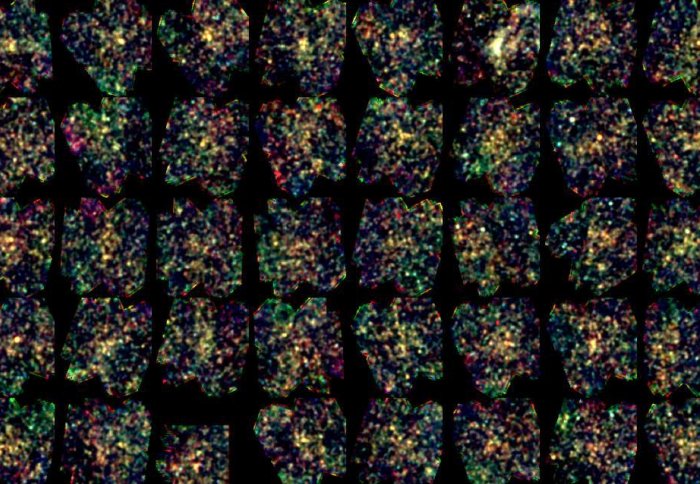
Collage of new galaxy clusters

Astronomers have spotted more than 200 rapidly star-forming clusters of galaxies that could shed light on galaxy evolution.
These clusters are the most massive objects in the universe, containing hundreds or thousands of galaxies. Early estimates of the new clusters predict they could be forming the equivalent of 7,000 Sun-sized stars per year. By studying their properties, astronomers hope to learn more about the formation of galaxies and galaxy clusters in the early universe.
Light takes time to travel, meaning that when we observe objects far away in the universe we are actually seeing them as they looked in the past. More detailed analysis is needed on the new clusters to estimate their ages accurately, but they could be up to 10 billion years old, dating from just 3 billion years after the universe first formed.
We had hints of these kinds of objects before, but this study found a huge number of these things.
– Dr David Clements
The star-forming galaxies in the clusters are thought to be early stages of what we see today as giant elliptical galaxies, containing many stars but little dust and gas. Dust and gas are used to form stars, meaning elliptical galaxies are highly evolved systems. Finding so many early galaxy clusters will allow researchers to study the evolution of these galaxies in greater depth.
The clusters were discovered by the Planck Collaboration, a large group of researchers from around the world. “We had hints of these kinds of objects before, and had found a few examples in previous studies, but this study found a huge number of these things,” said Dr David Clements from the Department of Physics at Imperial College London, who is part of the team. “That means we can now get a much clearer understanding of what's going on.”
The next steps will be to look in more detail at the clusters in order to define their ages and investigate the shape and environment of their star-forming galaxies. Looking at shapes can uncover galaxy collisions, where smaller galaxies combine into larger ones.
It is the collision of ever larger galaxies that are thought to form the giant elliptical galaxies. In fact, our own galaxy, the Milky Way, will collide with the Andromeda galaxy in approximately four billion years, forming a new giant elliptical galaxy.
Mass attractions
More detailed observations could also reveal the make-up of the clusters, and whether rapidly star-forming individual galaxies are surrounded by less productive galaxies, giving insight into the evolution of the system.
As some of the most massive systems in the universe today, galaxy clusters provide clues about the distribution of mass in the early universe. The Big Bang did not distribute matter evenly, causing very tiny fluctuations in the density of different areas of the universe. Small centres of mass attracted more matter through the action of gravity, eventually forming stars and galaxies. As huge centres of mass, galaxy clusters might reveal the limits of density differences in the early universe.
Galaxy clusters are rich in dark matter. Dark matter cannot be observed directly, but makes up most of the matter in the universe, exerting a large force of gravity. It’s this gravity that drives the accumulation of visible matter into galaxies and clusters.
Galaxy hunters
To find the clusters, the team combined data from the European Space Agency’s Planck and Herschel missions, which are both now finished. The Planck satellite could scan large areas of the sky, allowing the team to select candidates, which they then looked at more closely with the Herschel space observatory to confirm the presence of galaxy clusters.
Professor Hervé Dole from the Institut d’Astrophysique Spatiale in France, who led the analysis, said: “Although the data were taken a few years ago, when Planck and Herschel were operating, we’re only at the start of this project, with many exciting targets being followed up using other observatories. This is a fantastic effort, and more impressive results are expected in the coming months.”
-
'Planck intermediate results. XXVII. High-redshift infrared galaxy overdensity candidates and lensed sources discovered by Planck and confirmed by Herschel-SPIRE' by the Planck Collaboration is published in Astronomy and Astrophysics.
Supporters


Article text (excluding photos or graphics) available under an Attribution-NonCommercial-ShareAlike Creative Commons license.
Photos and graphics subject to third party copyright used with permission or © Imperial College London.
Reporter
Hayley Dunning
Communications Division

Contact details
Tel: +44 (0)20 7594 2412
Email: h.dunning@imperial.ac.uk
Show all stories by this author




Leave a comment
Your comment may be published, displaying your name as you provide it, unless you request otherwise. Your contact details will never be published.